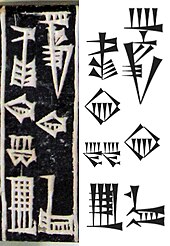
Back Ergatief Afrikaans Ergativo AN Casu ergativu AST Ергативно-абсолютивен строй Bulgarian Troad ergativel Breton Cas ergatiu Catalan Ergativ Czech Ergativ Danish Ergativ German Ergativo Esperanto

In grammar, the ergative case (abbreviated erg) is the grammatical case that identifies a nominal phrase[2] as the agent of a transitive verb in ergative–absolutive languages.[3]
- ^ Edzard, Dietz-Otto (2003). Sumerian Grammar. BRILL. p. 36. ISBN 978-90-474-0340-1.
- ^ Loos, Eugene. "Glossary of linguistic terms". LinguaLinks Library 5.0 Plus. Archived from the original on March 4, 2016. Retrieved September 27, 2013.
- ^ Haspelmath, Martin. 2022. Ergative, absolutive, accusative and nominative as comparative concepts. In Iomdin, Leonid & Milićević, Jasmina & Polguère, Alain (eds.), Lifetime linguistic inspirations: To Igor Mel’čuk, 201–213. Frankfurt: Peter Lang. (doi:10.5281/zenodo.7625026) (https://zenodo.org/record/7625026)